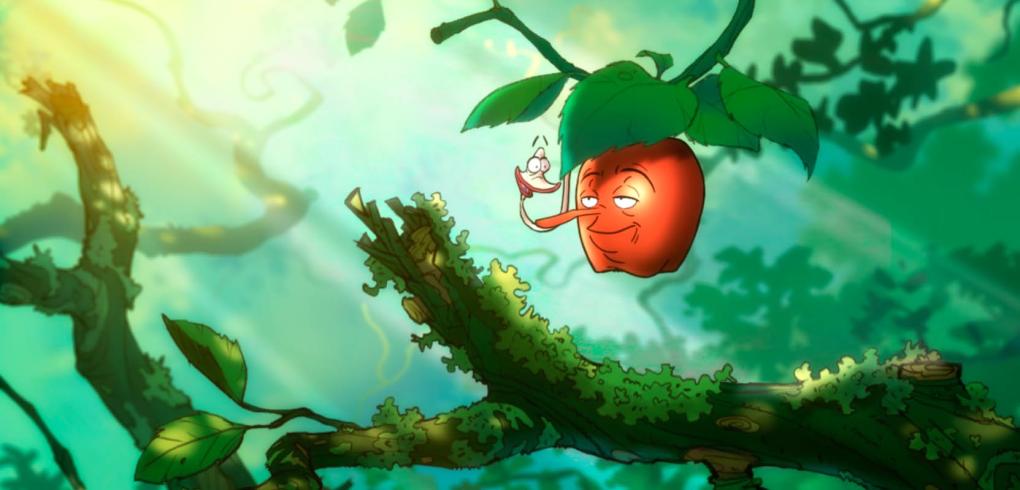“The great thing about doing things for kids is you get to be moral and say what you mean. I don’t have to tone down the message or shade it,” Anders Morgenthaler says.
"The great thing about doing things for kids is you get to be moral and say what yo mean. I don't have to tone down the message or shade it."
The director, writer and satirist is following up two dramas, "Princess" and "Echo", with "The Apple and the Worm", a fun, animated feature for a much younger audience. It was a pleasure, he says. “I have small children myself, and I’m really interested in telling stories for kids because they give you such a fantastic, direct response. There isn’t so much bullshit,” Morgenthaler tells me in his office at Copenhagen Bombay, the production company he runs with producer Sarita Christensen. Their company aims to make quality entertainment on different platforms for children and teens.
Morgenthaler, 36, is a graduate of the National Film School’s animation-directing programme. Besides filmmaking, he writes and illustrates books and turns out a daily comic strip for the Politiken newspaper – "Wulffmorgenthaler", a twice-removed, uncouth cousin of Gary Larson’s "Far Side", co-written with the stand-up comic Mikael Wulff. At rapidly growing Copenhagen Bombay, he and his coworkers mainly do films and TV productions for young audiences.
AN ANTI-DEPRESSING STORY
Morgenthaler is a member of the European Film Academy and, like all Academy members, he receives a box of the films that are nominated for that year’s European Film Awards. A few years ago, as he was looking through his first box of films, he had a revelation. “You watch 10 of them and they’re simply so depressing,” he says.
He asked himself why on earth no one was making films with a brighter outlook on life and realised that his own films for adults were no less depressing. Consequently, he decided to do a fun film that also had something on its mind.
"The Apple and the Worm" is the story of a selfabsorbed red apple named Torben who, like most other apples on his tree, dreams of becoming a handsome, brightly polished show apple. Naturally, he’s scared of everything that might sour life for an apple. When a friend of his is diagnosed with mites, Torben leads the charge to shake him out of the tree.
But Torben gets a taste of his own medicine when he is penetrated by a worm – a fast-talking, stubborn worm to boot. Soon, Torben, too, is rudely shaken out of his old life. Accompanied by the worm and another buddy, a pear-shaped apple who drops to the ground in a show of solidarity, Torben sets out through a vast, unknown, potentially hostile world to find a worm doctor. Along the way, the oddball trio meets a singingcherry, bigoted potatoes and cultivated vegetables, and Torben learns a thing or two about himself, which ultimately makes him a better apple.
OBSESSED WITH PERFECTION
“I did a picture book about an apple who got a worm,” Morgenthaler says. “Then what does an apple do? Make friends with the worm? Try to get rid of it?” It occurred to him that he could use apples as a symbol of a society that’s fearful and completely obsessed with perfection.
“I pictured Torben and his friends as a kind of Texas rednecks,” he says. “They meet some cultivated, fearful vegetables who take an intellectual angle on the civilised way for vegetables to live. They also meet some tropical party fruits – and some root vegetables, who live dry, dull lives and are totally rigid and unpleasant. The different environments that Torben and his friends visit on their trip mirror the human social structure.” All the same, the tone and language of Morgenthaler’s film is refreshingly frank and not at all politically correct.
“You can tell how children get all excited when you tell it to them straight,” he says. “The audience sits up when you go close to the boundaries of the acceptable.”
"The Apple and the Worm. Framegrab
WORLDS APART FROM PIXAR AND DISNEY
In 2006, Morgenthaler’s "Princess", a blend of animation and live action, was selected for the Directors’ Fortnight in Cannes. The film was inspired by Japanese anime, not only in its style but also in terms of production, which made it doable on a relatively low budget. In Morgenthaler’s concept, you don’t necessarily need 24 frames a second, but maybe only 12 or 16, to tell a story that engulfs the audience. The character design for the 2D-animated "The Apple and the Worm" is largely Morgenthaler’s own. Thefilm shows the same unpretentious and inventive approach to the animation process as "Princess".
“I am not rigid about animation at all. It should be fun and do the job, that’s all I ask. I certainly don’t mind if it’s gorgeous. I saw Bolt at the theatre and thought, ‘Jesus Christ, that’s gorgeous!’ Then I went home and looked at my hand-drawn film,” Morgenthaler shrugs.
“Of course, we’re talking about two entirely different things. I’m not trying to measure up to Disney, Pixar or DreamWorks,” he says. “My film tries to communicate a story inside a coherent universe in a completely different way. I know you can’t tell from looking at it, but when we started working on "The Apple and the Worm", we were looking at the classic Disney cartoons, the feelings they have and how they use layered backgrounds. We wanted a similar feeling combined with my characters. I choose to use the money I have as well as I can within the available limits.” For his next film, he is considering mixing 2D- and 3D-animation.
NOT AMERICAN-PERFECT
Morgenthaler tends to change a lot of things in the editing process – even the dialogue.
“The cool thing about animation is you have the freedom to do anything you want,” he says. “The technically obsessed would go, ‘But, then their mouths don’t match what they’re saying.’ I don’t give a shit! You have a mouth that moves. It can say anything.”
In general, he thinks it’s important for the European animation industry to do things its way instead of trying to copy the Americans.
“A lot of people make animated films by writing for years and years, until it’s almost American perfect, but Europeans by and large never get it right,” he says. “European films that try to be American generally do poorly, while films that dotheir own thing do well. European animation studios would like to do Pixar, but they can’t. They don’t have the money. So they do something that looks half-ass, or is half-ass. That’s no good. Europeans should be much less rigid about using animation. The French are getting close. That’s cool. And A. Film of Denmark is starting to get it. They don’t care how anything looks. They do animated comedies, like "Terkel in Trouble" and "Journey to Saturn", that are seen by the entire nation”.


